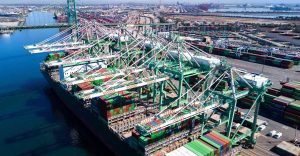Seaports in China include Shanghai Port, Shenzhen Port, Ningbo-Zhoushan Port, Qingdao Port, Guangzhou Port, Tianjin Port, Xiamen Port, Dalian Port, Fuzhou Port, Lianyungang Port, Zhanjiang Port, Zhuhai Port, Yantai Port, and Chongqing Port. These ports not only play a vital role in international trade but also serve as key drivers of China’s economic development.
1. Shanghai Port
Shanghai Port has been operational for over 175 years and is the world’s largest container port, located in Shanghai. Covering an area of about 3,619 km², the port handles more than 40 million TEUs annually. Its water depth ranges from 15 to 17 meters, accommodating the largest cargo ships. Situated approximately 25 km from Shanghai’s city center, the port contributes billions of USD to China’s GDP annually as a hub for international trade.
2. Shenzhen Port
Established in 1980, Shenzhen Port is located in Shenzhen, Guangdong Province, covering an area of about 349 km² and handling over 25 million TEUs annually. With a water depth of approximately 16-17 meters, it is located about 20 km from Shenzhen city center, one of China’s major economic hubs, and significantly drives the region’s rapid development.
3. Ningbo-Zhoushan Port
With over 100 years of operation, Ningbo-Zhoushan Port spans an area of approximately 3,720 km² and handles more than 30 million TEUs annually. Located in Ningbo and Zhoushan, Zhejiang Province, with water depths ranging from 16 to 18 meters, the port is about 20 km from Ningbo city center and is a critical contributor to local and national economies, generating billions of USD each year.
4. Qingdao Port
Qingdao Port has been operational for over 120 years, covering about 50 km² and handling over 20 million TEUs annually. Located in Qingdao, Shandong Province, its water depth ranges from 12 to 18 meters. Approximately 15 km from Qingdao’s city center, it is an important economic hub, contributing significantly to China’s GDP each year.
5. Guangzhou Port
Guangzhou Port has been in operation for more than 2,000 years, covering about 155 km² and handling over 20 million TEUs annually. With water depths ranging from 13-17 meters, it is located approximately 10 km from Guangzhou city center and plays a crucial role in the development of the Pearl River Delta region.
6. Tianjin Port
With over 160 years of history, Tianjin Port covers an area of about 121 km² and handles over 16 million TEUs annually. With a water depth of approximately 16-17 meters, the port is located about 170 km from Beijing and plays a vital role in the economy of Northern China, especially in the capital region.
7. Xiamen Port
Established in 1983, Xiamen Port covers an area of about 30 km² and handles around 10 million TEUs annually. With a water depth of about 17 meters, the port is located about 10 km from Xiamen city center and plays an important role in trade with Taiwan and the Fujian region.
8. Dalian Port
Dalian Port has been operational for over 120 years, covering about 346 km² and handling around 10 million TEUs annually. With water depths ranging from 15-18 meters, the port is located about 10 km from Dalian city center and significantly contributes to the economy of Northeast China, particularly in the oil and chemical industries.
9. Fuzhou Port
Established in 1968, Fuzhou Port covers an area of about 40 km² and handles around 5 million TEUs annually. With a water depth of about 15-16 meters, the port is located approximately 20 km from Fuzhou city center and plays a vital role in regional trade.
10. Lianyungang Port
Operational since 1933, Lianyungang Port covers an area of about 48 km² and handles around 4 million TEUs annually. With water depths ranging from 14-15 meters, the port is located about 30 km from Lianyungang city center and is an important economic contributor to the Northeast Asia region.
11. Zhanjiang Port
Zhanjiang Port has been operational for over 70 years, covering an area of about 14 km² and handling around 8 million TEUs annually. With a water depth of approximately 15-17 meters, the port is located about 10 km from Zhanjiang city center and plays a critical role in Southern China’s transportation, especially in heavy industries and petrochemicals.
12. Zhuhai Port
Zhuhai Port has been operational for over 35 years, covering an area of about 6 km² and handling approximately 2.5 million TEUs annually. With a water depth of about 13-16 meters, the port is located about 15 km from Zhuhai city center and plays a significant role in regional trade and commerce with Macau and Hong Kong, contributing substantially to the local economy.
13. Yantai Port
Yantai Port has been operational for over 150 years, covering an area of about 24 km² and handling around 4 million TEUs annually. With a water depth of about 14-17 meters, the port is located about 20 km from Yantai city center and plays an important role in Northeast China’s trade and transport, particularly in agriculture and food processing industries.
14. Chongqing Port
Chongqing Port has been operational for over 100 years, covering an area of about 30 km² and handling around 6 million TEUs annually. With a water depth of about 15-18 meters, the port is located within Chongqing city and serves as a key transportation hub in Southwest China, contributing significantly to the local economy through domestic and international freight, especially in industrial and agricultural goods.
The above information has been compiled by leading logistics experts regarding seaports in China. Businesses are encouraged to explore more about seaports in India on the Boom Logistics website.






